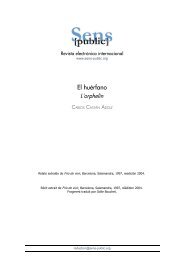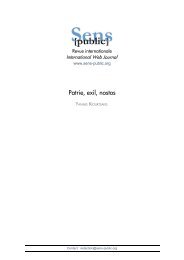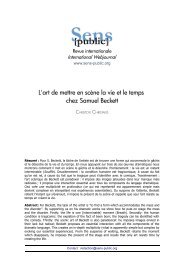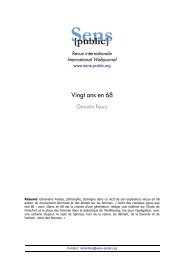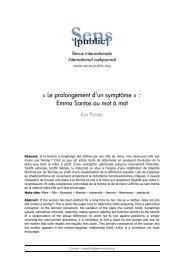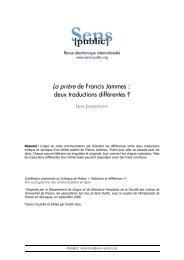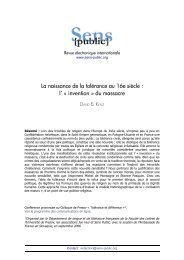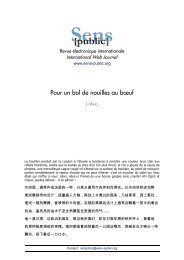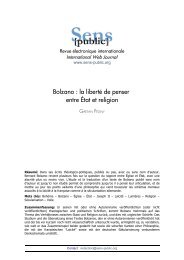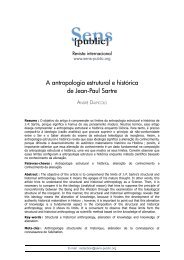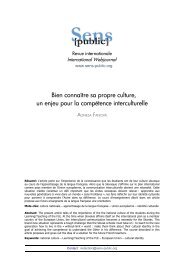The language situation in Sweden: the relationship ... - Sens Public
The language situation in Sweden: the relationship ... - Sens Public
The language situation in Sweden: the relationship ... - Sens Public
You also want an ePaper? Increase the reach of your titles
YUMPU automatically turns print PDFs into web optimized ePapers that Google loves.
Revue <strong>in</strong>ternationaleInternational Webjournalwww.sens-public.org'Cultural diversity, Multil<strong>in</strong>gualismand Ethnic m<strong>in</strong>orities <strong>in</strong> <strong>Sweden</strong>'*<strong>The</strong> <strong>language</strong> <strong>situation</strong> <strong>in</strong> <strong>Sweden</strong>:<strong>the</strong> <strong>relationship</strong> between <strong>the</strong> ma<strong>in</strong> <strong>language</strong>and <strong>the</strong> national m<strong>in</strong>ority <strong>language</strong>sRIINA HEIKKILÄAbstract: This article is based on <strong>the</strong> presentation at <strong>the</strong> conference “Cultural Diversity, Multil<strong>in</strong>gualism andEthnic M<strong>in</strong>orities <strong>in</strong> <strong>Sweden</strong>” arranged by <strong>The</strong> French Institute <strong>the</strong> 2 nd and 3 rd of September. <strong>The</strong> aim of <strong>the</strong>article is to give a short presentation of <strong>the</strong> <strong>language</strong> <strong>situation</strong> <strong>in</strong> <strong>Sweden</strong> today and to make a presentationon <strong>the</strong> ma<strong>in</strong> <strong>language</strong> Swedish and <strong>the</strong> five national m<strong>in</strong>ority <strong>language</strong>s.Contact : redaction@sens-public.org
Cultural diversity, Multil<strong>in</strong>gualism and Ethnicm<strong>in</strong>orities <strong>in</strong> <strong>Sweden</strong> * Kulturell mångfald,Flerspråkighet och Etniska m<strong>in</strong>oriteter i Sverige *Diversité culturelle, Multil<strong>in</strong>guisme et M<strong>in</strong>oritésethniques en SuèdeInternational Conference 2-3 September 2009 – Stockholm, <strong>Sweden</strong>Presentation and contentsCHRISTOPHE PREMAT<strong>The</strong> <strong>language</strong> <strong>situation</strong> <strong>in</strong> <strong>Sweden</strong>: <strong>the</strong> <strong>relationship</strong> between <strong>the</strong> ma<strong>in</strong> <strong>language</strong>and <strong>the</strong> national m<strong>in</strong>ority <strong>language</strong>sRIINA HEIKKILÄSpråklig mångfald och enhetssträvan – om svensk språkpolitik i tidsperspektivJEAN-FRANÇOIS BATTAILCultural diversity and <strong>in</strong>ternational law. In <strong>the</strong> field of human rights and identitiesJOSEPH YACOUBNational m<strong>in</strong>orities/ New m<strong>in</strong>orities. What similarities and differences<strong>in</strong> contemporary Europe?YVES PLASSERAUDIdentity conflicts among Oriental Christian <strong>in</strong> <strong>Sweden</strong>DAVID GAUNTMulticultural <strong>Sweden</strong>, assimilationist France: how and why national identitynarratives evolveNATHALIE BLANC-NOËLNational identity, <strong>in</strong>clusion and exclusion. An empirical <strong>in</strong>vestigationHANS LÖDÉN<strong>The</strong> dramatisation of violence from Montesquieu to Lars NorénGÉRARD WORMSER AND CAROLE DELYDiversity and similarity beyond ethnicity: migrants’ material practicesMAJA POVRZANOVIĆ FRYKMANAddress<strong>in</strong>g cultural differences result<strong>in</strong>g from immigration: a comparisonbetween French and Swedish public policiesCYRIL COULETCommunity <strong>in</strong>terpret<strong>in</strong>g <strong>in</strong> <strong>Sweden</strong> and its significance to guarantee<strong>in</strong>g legaland medical securityEVA NORSTRÖMPublished on l<strong>in</strong>e: 2010/10http://www.sens-public.org/article.php3?id_article=763© <strong>Sens</strong> <strong>Public</strong> | 2
Methods- A nit<strong>in</strong>ol stent frame was designed,simulated and manufactured- <strong>The</strong> leaflets are made from a th<strong>in</strong>PCU film- <strong>The</strong> leaflets are bonded to <strong>the</strong> stentframe us<strong>in</strong>g proprietary bond<strong>in</strong>gtechnology- Accelerated wear tests were conductedto test:- Durability of <strong>the</strong> stent frame- Function of <strong>the</strong> bond<strong>in</strong>g technologyLeaflet-stent framesimulationAccelerated wear tester, topview
RIINA HEIKKILÄ<strong>The</strong> <strong>language</strong> <strong>situation</strong> <strong>in</strong> <strong>Sweden</strong>...Romani can be regarded as a m<strong>in</strong>ority <strong>language</strong> s<strong>in</strong>ce it has been spoken <strong>in</strong> <strong>Sweden</strong> s<strong>in</strong>ce <strong>the</strong> 16 thcentury, but not for example Arabic or Turkish s<strong>in</strong>ce <strong>the</strong>y are relatively new <strong>language</strong>s;immigrants have spoken <strong>the</strong>m only s<strong>in</strong>ce <strong>the</strong> 20 th century <strong>in</strong> <strong>Sweden</strong>.<strong>The</strong> follow<strong>in</strong>g presentation of each <strong>language</strong> is based ma<strong>in</strong>ly on <strong>the</strong> booklet Sveriges officiellam<strong>in</strong>oritetsspråk (<strong>The</strong> official m<strong>in</strong>ority <strong>language</strong>s <strong>in</strong> <strong>Sweden</strong>) (7). <strong>The</strong> focus will be on number ofspeakers, education and <strong>language</strong> cultivation.It should be emphasized that <strong>the</strong> numbers of speakers of each <strong>language</strong> are noth<strong>in</strong>g butrough estimates, because <strong>in</strong> <strong>Sweden</strong> compil<strong>in</strong>g statistics on numbers of speakers of different<strong>language</strong>s or statistics on mo<strong>the</strong>r tongue or ethnic background is not allowed.F<strong>in</strong>nishF<strong>in</strong>nish has a special position amongst <strong>the</strong> m<strong>in</strong>ority <strong>language</strong>s <strong>in</strong> <strong>Sweden</strong>. It has been spoken<strong>in</strong> <strong>Sweden</strong> for at least 800 years. This is due to <strong>the</strong> fact that F<strong>in</strong>land and <strong>Sweden</strong> once were onecountry, and F<strong>in</strong>nish was spoken not only <strong>in</strong> <strong>the</strong> whole eastern part of <strong>the</strong> country (<strong>the</strong> currentstate of F<strong>in</strong>land) but also <strong>in</strong> large areas <strong>in</strong> <strong>the</strong> western part of <strong>the</strong> country (<strong>the</strong> current state of<strong>Sweden</strong>).S<strong>in</strong>ce F<strong>in</strong>nish is a majority <strong>language</strong> <strong>in</strong> <strong>the</strong> neighbour<strong>in</strong>g country F<strong>in</strong>land and F<strong>in</strong>nish <strong>language</strong>cultivation, standardization etc. have long traditions <strong>the</strong>re, <strong>the</strong> <strong>language</strong> cultivation work with <strong>the</strong>F<strong>in</strong>nish <strong>language</strong> <strong>in</strong> <strong>Sweden</strong> has been a lot easier than with for example Romani or Meänkieli,which could be said to be at <strong>the</strong> beg<strong>in</strong>n<strong>in</strong>g of <strong>the</strong> whole process of standardization, documentationand cultivation. <strong>The</strong> number of speakers of F<strong>in</strong>nish <strong>in</strong> <strong>Sweden</strong> is about 250 000.Accord<strong>in</strong>g to <strong>The</strong> Swedish National Agency for Education (Skolverket) <strong>the</strong>re were 3 033 pupilsstudy<strong>in</strong>g F<strong>in</strong>nish at comprehensive schools <strong>in</strong> October 2007. F<strong>in</strong>nish was on 11 th place <strong>in</strong> <strong>the</strong>statistics <strong>in</strong> regard to <strong>the</strong> mo<strong>the</strong>r tongues studied <strong>in</strong> <strong>the</strong> Swedish comprehensive school (o<strong>the</strong>rthan Swedish). <strong>The</strong>re are also seven <strong>in</strong>dependent public schools <strong>in</strong> which <strong>the</strong> education <strong>language</strong>is F<strong>in</strong>nish. All seven schools have toge<strong>the</strong>r about 1 000 pupils.At university level F<strong>in</strong>nish can be studied at <strong>the</strong> universities <strong>in</strong> Stockholm, Uppsala and Umeå,<strong>in</strong> <strong>the</strong> Mälardalen University and <strong>in</strong> Luleå University of Technology.<strong>The</strong> Language Council of <strong>Sweden</strong> is <strong>the</strong> organization that takes care of <strong>the</strong> <strong>language</strong>cultivation of F<strong>in</strong>nish, but <strong>the</strong>re are several special <strong>in</strong>terest groups and organizations work<strong>in</strong>g for<strong>the</strong> F<strong>in</strong>nish <strong>language</strong> and <strong>the</strong> F<strong>in</strong>nish-speak<strong>in</strong>g people <strong>in</strong> <strong>Sweden</strong>.Two of <strong>the</strong> organizations are <strong>The</strong> National Association of F<strong>in</strong>ns <strong>in</strong> <strong>Sweden</strong> and <strong>The</strong> <strong>Sweden</strong>F<strong>in</strong>nish Delegation. <strong>The</strong> Swedish public service broadcast<strong>in</strong>g companies, i.e. <strong>the</strong> Swedish Radio, aswell as <strong>the</strong> Swedish TV, have programs <strong>in</strong> F<strong>in</strong>nish and <strong>the</strong>re is also a weekly F<strong>in</strong>nish newspaper.Published on l<strong>in</strong>e: 2010/10http://www.sens-public.org/article.php3?id_article=763© <strong>Sens</strong> <strong>Public</strong> | 5
RIINA HEIKKILÄ<strong>The</strong> <strong>language</strong> <strong>situation</strong> <strong>in</strong> <strong>Sweden</strong>...MeänkieliAccord<strong>in</strong>g to <strong>the</strong> booklet Sveriges officiella m<strong>in</strong>oritetsspråk <strong>the</strong>re could have been about 75000 people speak<strong>in</strong>g Meänkieli <strong>in</strong> 1980.Accord<strong>in</strong>g to statistics from <strong>The</strong> Swedish National Agency for Education <strong>the</strong>re were 153 pupilsstudy<strong>in</strong>g Meänkieli at comprehensive school <strong>in</strong> 2007. Meänkieli was on 42 nd place <strong>in</strong> <strong>the</strong> statisticsamongst <strong>the</strong> mo<strong>the</strong>r tongues studied.On a higher level you can study Meänkieli at two universities <strong>in</strong> nor<strong>the</strong>rn <strong>Sweden</strong>. <strong>The</strong>se are<strong>the</strong> University of Umeå and Luleå University of Technology.Language documentation of Meänkieli is conducted by <strong>The</strong> Institute for Language andFolklore, though not by <strong>The</strong> Language Council of <strong>Sweden</strong> but its department <strong>in</strong> Umeå. A greatpart of <strong>the</strong> Meänkieli-speakers live <strong>in</strong> nor<strong>the</strong>rn <strong>Sweden</strong> and it is regarded to be practical that <strong>the</strong>person tak<strong>in</strong>g care of Meänkieli is situated near <strong>the</strong> users of <strong>the</strong> <strong>language</strong>.<strong>The</strong>re are several special <strong>in</strong>terest groups work<strong>in</strong>g for Meänkieli and <strong>the</strong> Swedish public serviceradio sends programs <strong>in</strong> Meänkieli. <strong>The</strong>re is also at least one newspaper <strong>in</strong> Meänkieli.Romani chibIt is estimated that <strong>the</strong> number of Romani speakers <strong>in</strong> <strong>Sweden</strong> could be somewhere around20 000, but estimates vary a lot.In October 2007 <strong>the</strong>re were 360 pupils study<strong>in</strong>g <strong>the</strong> three different varieties of Romani. <strong>The</strong>sevarieties are Lovari, Kelderash and Kale. At comprehensive school, Romani was on 31 st place <strong>in</strong><strong>the</strong> statistics.<strong>The</strong> Swedish public service radio has news programs <strong>in</strong> Romani. <strong>The</strong>re are also several special<strong>in</strong>terest groups look<strong>in</strong>g after <strong>the</strong> Roma peoples <strong>in</strong>terests. One of <strong>the</strong>m is <strong>The</strong> Delegation for RomaIssues, which was founded <strong>in</strong> February 2007 by <strong>the</strong> Swedish government (8).You can study Romani Chib at <strong>the</strong> University of L<strong>in</strong>köp<strong>in</strong>g. <strong>The</strong>y are giv<strong>in</strong>g a 15-credit course<strong>in</strong> Romani Chib and <strong>the</strong> Romani culture.<strong>The</strong>re are two persons work<strong>in</strong>g with <strong>the</strong> Romani <strong>language</strong> at <strong>The</strong> Language Council of<strong>Sweden</strong>. <strong>The</strong>y represent <strong>the</strong> Arli and Kale varieties.Sami<strong>The</strong> Sami <strong>language</strong> is spoken by <strong>the</strong> Sami people, <strong>the</strong> only <strong>in</strong>digenous people amongst <strong>the</strong>official m<strong>in</strong>ority groups <strong>in</strong> <strong>Sweden</strong>.<strong>The</strong>re could be about 20 000 Sami people liv<strong>in</strong>g <strong>in</strong> <strong>Sweden</strong>, and about 7 000 of <strong>the</strong>m speakSami. It should be mentioned that <strong>the</strong> Sami <strong>language</strong> <strong>in</strong> fact <strong>in</strong>cludes several varieties or dialects,which are not always understandable among <strong>the</strong> different Sami groups <strong>the</strong>mselves.Published on l<strong>in</strong>e: 2010/10http://www.sens-public.org/article.php3?id_article=763© <strong>Sens</strong> <strong>Public</strong> | 6
RIINA HEIKKILÄ<strong>The</strong> <strong>language</strong> <strong>situation</strong> <strong>in</strong> <strong>Sweden</strong>...Accord<strong>in</strong>g to statistics from <strong>The</strong> Swedish National Agency for Education <strong>the</strong> total number ofpupils study<strong>in</strong>g Sami <strong>in</strong> October 2007 was 384. Sami was on 30 th place <strong>in</strong> <strong>the</strong> statistics. On ahigher level, <strong>the</strong> Sami <strong>language</strong> can be studied at <strong>the</strong> universities of Umeå and Uppsala.<strong>The</strong> Swedish public service broadcast<strong>in</strong>g companies have programs <strong>in</strong> Sami.<strong>The</strong> Sami Parliament (9), Samet<strong>in</strong>get, is an important special <strong>in</strong>terest organization and publicauthority represent<strong>in</strong>g <strong>the</strong> Sami people <strong>in</strong> <strong>Sweden</strong>.Swedish government has a Sami Policy (10) and <strong>the</strong> Government Offices of <strong>Sweden</strong> offermore <strong>in</strong>formation about <strong>the</strong> subject.YiddishAccord<strong>in</strong>g to <strong>the</strong> booklet Sveriges officiella m<strong>in</strong>oritetsspråk <strong>the</strong>re are about 2 000–3 000speakers of Yiddish <strong>in</strong> <strong>Sweden</strong>. Yiddish has been spoken <strong>in</strong> <strong>Sweden</strong> s<strong>in</strong>ce <strong>the</strong> 17 th century, but <strong>the</strong>Jewish people <strong>in</strong> <strong>Sweden</strong> have always been at least bil<strong>in</strong>gual, often multil<strong>in</strong>gual.You can study Yiddish at comprehensive school, often through distance tuition. And <strong>the</strong>University of Lund offers base level courses <strong>in</strong> Yiddish.Adm<strong>in</strong>istrative areas for m<strong>in</strong>ority <strong>language</strong>s<strong>The</strong>re is special legislation that makes it possible for speakers of F<strong>in</strong>nish, Meänkieli and Samito use <strong>the</strong>ir own m<strong>in</strong>ority <strong>language</strong>s <strong>in</strong> contacts with public authorities <strong>in</strong> <strong>the</strong> adm<strong>in</strong>istrative areas.In <strong>the</strong>se areas <strong>the</strong> m<strong>in</strong>ority <strong>language</strong>s have been used for a long time. <strong>The</strong> legislation first<strong>in</strong>cluded only some municipalities <strong>in</strong> nor<strong>the</strong>rn <strong>Sweden</strong>. <strong>The</strong> adm<strong>in</strong>istrative area for Sami were <strong>the</strong>municipalities of Arjeplog, Gällivare, Jokkmokk and Kiruna and for F<strong>in</strong>nish and Meänkieli <strong>the</strong>adm<strong>in</strong>istrative area were Gällivare, Haparanda, Kiruna, Pajala and Övertorneå.However, because of <strong>the</strong> new legislation regard<strong>in</strong>g to national m<strong>in</strong>orities and m<strong>in</strong>ority<strong>language</strong>s <strong>in</strong> <strong>Sweden</strong>, which will enter <strong>in</strong>to force <strong>the</strong> 1 st of January 2010, <strong>the</strong> adm<strong>in</strong>istrative areaswill be extended.<strong>The</strong>re are also o<strong>the</strong>r reforms. <strong>The</strong> right to use one’s m<strong>in</strong>ority <strong>language</strong> will <strong>in</strong>clude also o<strong>the</strong>rcontacts than communication with public authorities. Now it will be possible to use <strong>the</strong> m<strong>in</strong>ority<strong>language</strong>s also when deal<strong>in</strong>g with <strong>the</strong> preschool for six-year olds and with <strong>the</strong> healthcare for <strong>the</strong>elderly. <strong>The</strong> state of <strong>Sweden</strong> is support<strong>in</strong>g <strong>the</strong> extension of <strong>the</strong> adm<strong>in</strong>istrative areas by giv<strong>in</strong>g <strong>the</strong>municipalities <strong>in</strong> question government subsidies worth 50 million Swedish crowns. It is possible foro<strong>the</strong>r municipalities to jo<strong>in</strong> <strong>the</strong> adm<strong>in</strong>istrative areas voluntarily, but <strong>the</strong>y have to be able to offer<strong>the</strong> earlier mentioned services to <strong>the</strong> citizens.Published on l<strong>in</strong>e: 2010/10http://www.sens-public.org/article.php3?id_article=763© <strong>Sens</strong> <strong>Public</strong> | 7
RIINA HEIKKILÄ<strong>The</strong> <strong>language</strong> <strong>situation</strong> <strong>in</strong> <strong>Sweden</strong>...<strong>The</strong> adm<strong>in</strong>istrative area of <strong>the</strong> F<strong>in</strong>nish <strong>language</strong><strong>The</strong> adm<strong>in</strong>istrative area of <strong>the</strong> F<strong>in</strong>nish <strong>language</strong> will <strong>in</strong>clude 18 new municipalities around <strong>the</strong>lake Mälaren. <strong>The</strong>se are Botkyrka, Eskilstuna, Hallstahammar, Han<strong>in</strong>ge, Hudd<strong>in</strong>ge, Håbo, Köp<strong>in</strong>g,Sigtuna, Solna, Stockholm, Södertälje, Tierp, Upplands Väsby, Upplands-Bro, Uppsala, Älvkarleby,Österåker and Östhammar. <strong>The</strong> five nor<strong>the</strong>rn municipalities will also rema<strong>in</strong> a part of <strong>the</strong>adm<strong>in</strong>istrative area, thus <strong>the</strong> adm<strong>in</strong>istrative areas new number of municipalities will be 23.<strong>The</strong> adm<strong>in</strong>istrative area of <strong>the</strong> Meänkieli <strong>language</strong><strong>The</strong> adm<strong>in</strong>istrative area of Meänkieli is not extended, s<strong>in</strong>ce <strong>the</strong> area already <strong>in</strong>cludes <strong>the</strong>municipalities <strong>in</strong> which Meänkieli is mostly spoken. <strong>The</strong>se municipalities are Gällivare, Haparanda,Kiruna, Pajala and Övertorneå.<strong>The</strong> adm<strong>in</strong>istrative area of <strong>the</strong> Sami <strong>language</strong><strong>The</strong> adm<strong>in</strong>istrative area of Sami will <strong>in</strong>clude 13 new municipalities. <strong>The</strong>se are Arvidsjaur, Berg,Härjedalen, Lycksele, Malå, Sorsele, Storuman, Strömsund, Umeå, Vilhelm<strong>in</strong>a, Åre, Älvdalen andÖstersund. <strong>The</strong> five earlier municipalities – Arjeplog, Gällivare, Jokkmokk and Kiruna – will rema<strong>in</strong>a part of <strong>the</strong> adm<strong>in</strong>istrative area.Education <strong>in</strong> m<strong>in</strong>ority <strong>language</strong>s<strong>The</strong> Swedish government decided <strong>in</strong> 2008 that education <strong>in</strong> <strong>the</strong> national m<strong>in</strong>ority <strong>language</strong>s(lessons <strong>in</strong> comprehensive school and <strong>in</strong> upper secondary school) is to be equal with <strong>the</strong> education<strong>in</strong> <strong>the</strong> mo<strong>the</strong>r tongue Swedish.This means that <strong>the</strong> municipality, <strong>in</strong> which a pupil speak<strong>in</strong>g one of <strong>the</strong> five m<strong>in</strong>ority <strong>language</strong>slives, must arrange lessons <strong>in</strong> <strong>the</strong> m<strong>in</strong>ority <strong>language</strong> <strong>in</strong> question. <strong>The</strong> m<strong>in</strong>ority <strong>language</strong> doesn’thave to be <strong>in</strong> everyday use <strong>in</strong> <strong>the</strong> pupil’s home. <strong>The</strong> municipality also has to offer education eventhough <strong>the</strong>re is only one pupil who wants to be tutored.<strong>The</strong> government made this decision to fulfil <strong>the</strong> European Charter for Regional or M<strong>in</strong>orityLanguages and <strong>the</strong> Framework Convention for <strong>the</strong> Protection of National M<strong>in</strong>orities.<strong>The</strong> Language Council of <strong>Sweden</strong> and <strong>the</strong> <strong>language</strong> cultivationLanguage cultivation, or <strong>language</strong> plann<strong>in</strong>g, <strong>in</strong>volves <strong>the</strong> mak<strong>in</strong>g of handbooks, giv<strong>in</strong>g lecturesand l<strong>in</strong>guistic guidance and rais<strong>in</strong>g people's l<strong>in</strong>guistic awareness, but it does also entail long-termefforts to <strong>in</strong>fluence <strong>the</strong> <strong>language</strong> <strong>situation</strong> <strong>in</strong> <strong>the</strong> country.Published on l<strong>in</strong>e: 2010/10http://www.sens-public.org/article.php3?id_article=763© <strong>Sens</strong> <strong>Public</strong> | 8
RIINA HEIKKILÄ<strong>The</strong> <strong>language</strong> <strong>situation</strong> <strong>in</strong> <strong>Sweden</strong>...<strong>The</strong> Language Council of <strong>Sweden</strong> (<strong>in</strong> Swedish Språkrådet) is <strong>the</strong> primary <strong>in</strong>stitution for<strong>language</strong> cultivation <strong>in</strong> <strong>Sweden</strong>. It is a department of <strong>the</strong> official <strong>language</strong> authority <strong>The</strong> Institutefor Language and Folklore (<strong>in</strong> Swedish Institutet för språk och folkm<strong>in</strong>nen).<strong>The</strong> Institute for Language and Folklore has departments <strong>in</strong> five cities <strong>in</strong> <strong>Sweden</strong>. Those areGo<strong>the</strong>nburg, Lund, Stockholm, Uppsala and Umeå. <strong>The</strong> Language Council of <strong>Sweden</strong> is placed <strong>in</strong>Stockholm, but <strong>the</strong> departments <strong>in</strong> <strong>the</strong> o<strong>the</strong>r cities concentrate on for example names, placenames and dialects. <strong>The</strong> Institute has about 100 employees.<strong>The</strong>re are about 20 people work<strong>in</strong>g at <strong>The</strong> Language Council and most of <strong>the</strong>m work as<strong>language</strong> advisors. Swedish, F<strong>in</strong>nish, Romani and <strong>the</strong> Swedish Sign Language are <strong>the</strong> <strong>language</strong>srepresented <strong>in</strong> <strong>The</strong> Language Council. <strong>The</strong>re are also people work<strong>in</strong>g with pla<strong>in</strong> <strong>language</strong> at <strong>the</strong>Council. Pla<strong>in</strong> <strong>language</strong> advisors work for <strong>the</strong> Swedish <strong>language</strong> be<strong>in</strong>g well formulated, simple andcomprehensible <strong>in</strong> official and public use.<strong>The</strong> <strong>language</strong> cultivation <strong>in</strong> Sami is taken care of by <strong>The</strong> Sami Parliament and <strong>the</strong> Institute’sdepartment <strong>in</strong> Umeå <strong>in</strong> nor<strong>the</strong>rn <strong>Sweden</strong> represents Meänkieli.<strong>The</strong> Council's mission is to monitor <strong>the</strong> development of spoken and written Swedish and alsoto monitor <strong>the</strong> use and status of all o<strong>the</strong>r <strong>language</strong>s spoken <strong>in</strong> <strong>Sweden</strong>. Primarily, that meanspromot<strong>in</strong>g <strong>the</strong> use of Swedish sign <strong>language</strong> and our five official m<strong>in</strong>ority <strong>language</strong>s F<strong>in</strong>nish,Meänkieli, Sami, Romani and Yiddish.<strong>The</strong> Council gives advice by telephone and e-mail <strong>in</strong> questions of <strong>language</strong> usage. <strong>The</strong> Councilalso publishes handbooks, newsletters and word lists and organizes conferences and sem<strong>in</strong>ars.Yet ano<strong>the</strong>r task for <strong>the</strong> Council is to streng<strong>the</strong>n <strong>the</strong> Nordic <strong>language</strong> unity. Similar <strong>language</strong>councils exist also <strong>in</strong> <strong>the</strong> o<strong>the</strong>r Nordic countries.Published on l<strong>in</strong>e: 2010/10http://www.sens-public.org/article.php3?id_article=763© <strong>Sens</strong> <strong>Public</strong> | 9
RIINA HEIKKILÄ<strong>The</strong> <strong>language</strong> <strong>situation</strong> <strong>in</strong> <strong>Sweden</strong>...Source material and for fur<strong>the</strong>r read<strong>in</strong>g1. For fur<strong>the</strong>r <strong>in</strong>formation about <strong>The</strong> European Charter for Regional or M<strong>in</strong>ority Languages, see<strong>the</strong> website of <strong>The</strong> Council of Europe:http://conventions.coe.<strong>in</strong>t/treaty/Commun/QueVoulezVous.asp?NT=148&CL=ENG2. For fur<strong>the</strong>r <strong>in</strong>formation, see <strong>the</strong> Bill Bästa språket – en samlad svensk språkpolitik:http://www.reger<strong>in</strong>gen.se/sb/d/108/a/50761 (<strong>in</strong> Swedish)3. <strong>The</strong> Declaration on a Nordic Language Policy is available <strong>in</strong> <strong>the</strong> Nordic <strong>language</strong>s Danish,Faroese, F<strong>in</strong>nish, Greenlandic, Icelandic, Norwegian, Sami and Swedish and also <strong>in</strong> English. <strong>The</strong>Declaration is also available for download<strong>in</strong>g on <strong>the</strong> websitehttp://www.norden.org/en/publications/publications/2007-746/at_download/publicationfile).<strong>The</strong> ISBN-number of <strong>the</strong> publication is 978-92-893-1590-6.4. For fur<strong>the</strong>r <strong>in</strong>formation, see <strong>the</strong> Summary of <strong>the</strong> Government Bill Language for All by <strong>the</strong>Government Offices of <strong>Sweden</strong> (<strong>in</strong> English):http://www.reger<strong>in</strong>gen.se/content/1/c6/12/33/49/8f390fda.pdf5. For fur<strong>the</strong>r <strong>in</strong>formation about <strong>The</strong> Framework Convention for <strong>the</strong> Protection of NationalM<strong>in</strong>orities, see <strong>the</strong> website of <strong>The</strong> Council of Europe:http://conventions.coe.<strong>in</strong>t/Treaty/Commun/QueVoulezVous.asp?NT=157&CL=ENG6. For fur<strong>the</strong>r read<strong>in</strong>g, see <strong>the</strong> <strong>in</strong>formation sheet National M<strong>in</strong>orities by <strong>the</strong> Government Offices of<strong>Sweden</strong>:http://www.sweden.gov.se/sb/d/2184/a/19444and <strong>The</strong> Swedish Govenment’s Human Rights Website:http://www.manskligarattigheter.gov.se/extra/pod/?id=55&module_<strong>in</strong>stance=2&action=pod_show(both <strong>in</strong> English)7. Sveriges officiella m<strong>in</strong>oritetsspråk – F<strong>in</strong>ska, meänkieli, samiska, romani, jiddisch ochteckenspråk. Småskrift utgiven av Svenska språknämnden 2003 (<strong>in</strong> Swedish). Published byNorstedts Akademiska Förlag 2003 with <strong>the</strong> ISBN-number 91-7297-611-X.8. For fur<strong>the</strong>r read<strong>in</strong>g, see <strong>the</strong> <strong>in</strong>formation sheet <strong>The</strong> Delegation for Roma Issues by <strong>the</strong>Government Offices of <strong>Sweden</strong>:http://www.romadelegationen.se/dynamaster/file_archive/080924/8649012cecd4affc58173c3a2dcbfc84/Infofolder_engelsk_080904.pdf (<strong>in</strong> English)9. For fur<strong>the</strong>r <strong>in</strong>formation about <strong>The</strong> Sami Parliament, see <strong>the</strong> website:http://www.samet<strong>in</strong>get.se/english (<strong>in</strong> English).10. For fur<strong>the</strong>r read<strong>in</strong>g, see <strong>the</strong> <strong>in</strong>formation about <strong>the</strong> Sami policy by <strong>the</strong> Government Offices of<strong>Sweden</strong> (<strong>in</strong> English):http://www.sweden.gov.se/sb/d/2184/a/66267Published on l<strong>in</strong>e: 2010/10http://www.sens-public.org/article.php3?id_article=763© <strong>Sens</strong> <strong>Public</strong> | 10



